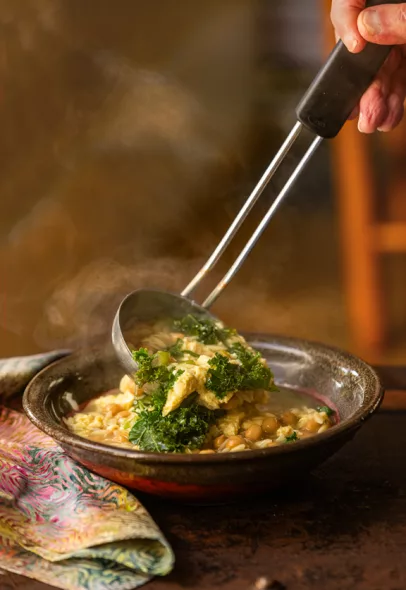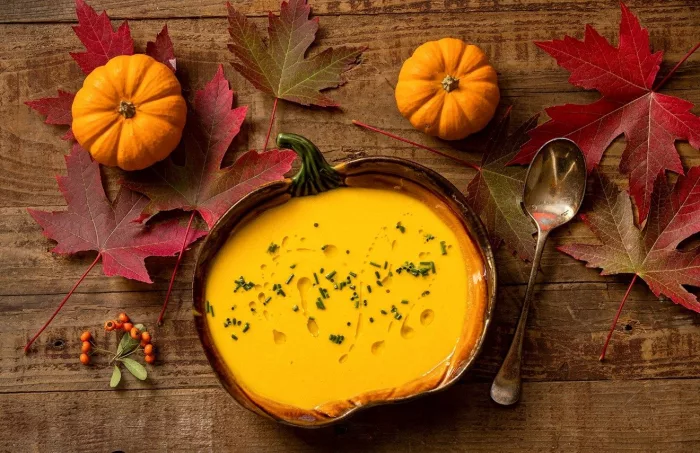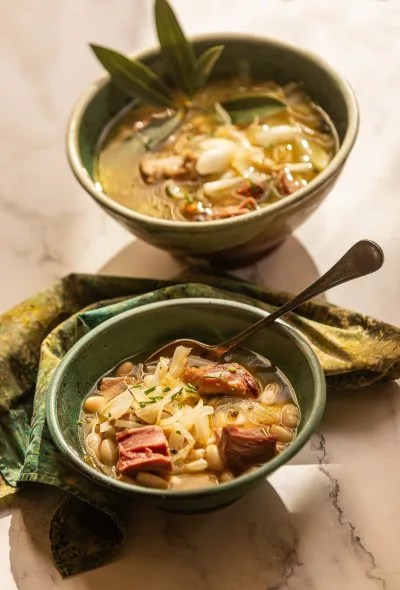It’s been a stretch with our warm weather recently but it finally feels like Fall. This is my favorite time of year when soups reign.
The history of soup is as old as the history of cooking. It is a universal comfort food found in all cuisines and cultures. Soup provides basic sustenance as well as being the centerpiece for celebrations and festivals. Soups are also easy food – – both to make and to eat and require very little equipment. They can be a snack, the opener for the meal, the main course or be the entire meal including breakfast.
Soup helps to feed a crowd, is nutritious and, the conventional wisdom is that they provide a cure-all for defeating flu, a cold or when nursing a hangover (that’s your problem, however). The modern restaurant industry is said to be based on soup. Restoratifs as they were called gave rise to the word “restaurant” and were the first items served in public restaurants in 18th century Paris, the birthplace of restaurants.
Every language it seems has a word or two for soup: Sopa in Spanish, Soupe and Potage in French, Soppa in Swedish, Anraith in Irish, Isobho in Zulu, Su’p in Vietnamese and more.
There are countless proverbs, legends and trivia about soup. Just a few:
A Portuguese\Spanish proverb (some dispute its origin) declares: “Of soup and love, the first is the best.”
Escoffier declared: “Of all the items on the menu, soup is that which exacts the most delicate perfection and the strictest attention.”
A Yiddish saying notes that “Troubles are easier to take with soup than without.”
To dream of soup is a forerunner of good tidings and comfort.
To see others enjoying soup, foretells that you will have many good chances to marry.
For a young woman to make soup, signifies that she will not be compelled to do menial work in her household, as she will marry a wealthy man.
In the court of Louis XI, the ladies were so vain that they lived almost exclusively on broths and consommés because they thought that chewing food would distort their faces by developing ugly facial muscles!
Frank Sinatra reportedly always asked for chicken and rice soup to be available to him in his dressing rooms before he went on stage. He said it always cleared his mind and settled his tummy.
Another famous person who loved soup was Andy Warhol. He told someone that he painted those famous soup cans because it’s what he had for lunch . . .every day for 20 years!
Beethoven notably said, “Only the pure of heart can make a good soup.”
Molière, “I live on good soup, not on fine words.”
Here are some of my favorite easy soups and what you are likely to get if you come to my house for a meal this time of year:

ITALIAN EGG-DROP SOUP
Serves 6
Stracciatella or rag soup as it’s known in Italy is named for the straggly, raggy appearance created by dribbling eggs beaten with cheese into warm stock. it’s a cinch to throw together with things you probably already have on hand. Use whatever small pasta you like.
4 large eggs, lightly beaten
6 tablespoons freshly grated parmesan cheese
6 cups chicken or vegetable broth
2 cups water
1 cup small pasta, such as ditalini preferably whole wheat
1 15-ounce can chickpeas or cannellini beans, drained and rinsed
1 teaspoon crushed fennel seed
3 cups chopped spinach, Swiss chard, or arugula or a combination, stems discarded
1 cup scallions, sliced on the bias, divided
Salt and freshly ground black pepper to taste
2 tablespoons freshly squeezed lemon juice or to taste
Whisk the eggs and parmesan together is a small bowl and set aside.
In a large pot or Dutch oven, combine broth, water, pasta, chickpeas, and fennel seed over high heat. Cover. Once mixture comes to a boil, uncover and cook 4 to 5 minutes. Add greens and scallions. Stir and cook until pasta is just tender, another couple of minutes. Drop heat to a simmer. Slowly pour egg mixture in soup, stirring constantly. Season with salt and pepper. Add lemon juice and serve immediately.
GREEN MINESTRONE
Serves 6 – 8
You’ll need a total of nine cups of shredded greens for this soup. Use one or any combination of the following: Swiss chard, spinach, escarole, green cabbage, or kale. The more variety the better.
3 tablespoons olive oil
3 cups chopped onion
2 cups chopped fresh fennel bulb, chopped
1 cup chopped celery
Salt and freshly ground pepper to taste
1 pound boiling potatoes (about 3), peeled and cut into 1/2-inch cubes
6 – 7 cups chicken broth preferably homemade
A nice hunk of Parmesan rind
1/2 cup tubetti, riso or other small macaroni
4 cups packed Swiss chard leaves, tough stems removed, washed well and shredded
5 cups young spinach, stems removed, washed well and shredded
1/3 cup or so freshly grated Parmesan or Pecorino cheese
In a large saucepan, heat the oil over moderately low heat. Add the onion, fennel, celery, salt and pepper and cook, stirring occasionally, until the vegetables start to soften, about 10 minutes.
Add the potatoes, broth, water and the rind and bring to a boil. Reduce the heat and simmer for 5 minutes. Stir in the pasta and simmer for 5 minutes longer.
Add the Swiss chard and spinach and bring the soup back to a simmer. Cook, stirring occasionally, until the greens are wilted and the pasta is tender, about 5 minutes longer.
Remove the rind and either eat it or save for another soup. Ladle into warm bowls and top with the grated parmesan.

15 MINUTE CREAMY TOMATO SOUP
Serves 4
This is delicious on its own, but I also like it as a base for any additions you might want to add like roasted mushrooms or tofu or seared scallops. It’s also vegan if you leave out the cheese garnish.
1/3 cup extra virgin olive oil, divided plus more for garnish
2 cloves garlic, finely chopped
1 cup finely chopped onion
1 teaspoon dried oregano
1/2 teaspoon fennel seed
Big pinch red pepper flakes
2 slices white bread, crusts removed and torn into 1-inch pieces
1 28-ounce can whole peeled tomatoes, preferably Fire Roasted
2-1/2 cups stock or water
Salt and freshly ground pepper to taste
For garnish: Chopped chives, freshly grated pecorino cheese and more olive oil
Heat 2 tablespoons olive oil in a large saucepan over medium high heat. Add garlic, onions, oregano, fennel seed and red pepper flakes. Cook, stirring until onion are softened but not brown, about 3 minutes. Add bread and tomatoes. Mash the tomatoes with potato masher or whisk. Add stock or water and bring to a boil over high heat. Reduce to a simmer and cook for 5 minutes.
Transfer soup to a blender. Blend soup starting at low speed. You may have to do in two batches. With blender running, gradually add remaining olive to form a smooth emulsion. Season soup to your taste with salt and pepper. Ladle into individual bowls and top with chives, pecorino and more olive oil.
WILD MUSHROOM HUNTER’S SOUP
Serves 6
This was a soup thrown together in camp after a day of wild mushroom hunting along the Sonoma coast of California. It resulted from what we had on hand. It’s very simple and if you are lucky enough to have found some other wild edibles such as ramps (wild leeks), a young cress, lamb’s quarters, etc. – – throw them in too! If you have a question about these wild edibles pull out that old copy of Euell Gibbons book: Stalking the Wild Asparagus as a starting point.
4 tablespoons olive oil
2-1/2 cups thinly sliced onions
2 tablespoons slivered garlic
1-1/2 pounds fresh, cleaned wild or cultivated mushrooms sliced thickly*
1-1/2 cups fresh or canned diced tomatoes in juice
6 cups rich chicken, mushroom or vegetable stock
Salt and freshly ground pepper
1/3 cup ruby port, calvados or amontillado sherry or to taste
2 tablespoons finely grated lemon zest
Garnish: Freshly grated Parmesan or Asiago cheese and chopped fresh herbs such as parsley, chives, basil and/or chervil
Heat 2 tablespoons of olive oil in a deep saucepan and cook the onions and garlic over moderate heat until they are lightly golden. While onion mixture is cooking, sauté the mushrooms in remaining olive oil in a separate sauté pan over high heat until they are cooked through and lightly browned. Add mushrooms to onion mixture along with the tomato and stock. Bring to a boil and then reduce heat and simmer for 3 or 4 minutes. Stir in port and zest and correct seasoning with salt and pepper just before serving. Serve in warm bowls or mugs garnished with a good sprinkling of cheese and chopped fresh herbs.
*A caution here – – only use wild mushrooms that you are certain are edible. If you are not a hunter you can certainly substitute cultivated exotic mushrooms found in the market such as Maitake, Trumpets, Oyster or “regular” mushrooms such as shiitake, cremini, portabella, oyster, etc. Adding dried Porcini or Field blend mushrooms oyster, etc. Adding dried Porcini or Field blend mushrooms add a wonderful earthiness. If you are interested in foraging wild mushrooms, contact and join your local Mycological Society which are everywhere that those delicious fungi grow.
TOM YUM GAI: HOT AND SOUR CHICKEN SOUP
Serves 4
One of the most popular dishes in Thailand. It is served there throughout the day. I’m using chicken here, but you could substitute shrimp or other fish or tofu for a vegetarian version. I’m leaving the lemongrass, galangal and lime leaves in the soup. Instruct your guests not to eat them. You can also strain them out before adding the chicken. The addition of some rice noodles would also be great.
2 tablespoons fish sauce
3 tablespoons fresh lime juice or to taste
1 tablespoon Thai red chile paste (nam prik pao) or other chile paste*
1 stalk lemongrass, outer leaves removed, cut into 2-inch sections and crushed
6 quarter size slices (3/4 ounce) galangal or ginger root
3 kaffir lime leaves, chopped in quarters or substitute lime peels from 1 large lime
4 cups chicken broth
10 ounces boneless, skinless chicken breast, sliced crosswise into 1/4-inch slices
1/2 cup shiitake mushrooms, stems removed and sliced
6 grape or cherry tomatoes, cut in half
Salt and freshly ground pepper (preferably white)
1/4 cup scallions, thinly sliced on the diagonal
Cilantro leaves for garnish
*Alternatively use Indonesian Sambal Oelek or Korean Gochujang
Whisk together the fish sauce, lime juice and chile paste in a small bowl.
Combine the lemongrass, galangal, kaffir lime leaves and broth in a medium saucepan over high heat. Bring to a boil; cook for 2 to 3 minutes.
Add the chicken to the pan a slice or two at a time to prevent them from sticking together. Once the liquid returns to a strong simmer, add the mushrooms and tomatoes. Cook for 3 to 4 minutes, until the chicken has cooked through.
Remove from the heat; stir in the fish sauce mixture. Taste and adjust hot/sour/salt flavors to your liking. Top with scallions and cilantro and serve immediately.

CURRIED WINTER SQUASH SOUP
Serves 8
A simple-to-make warming soup for cold weather. I have called for kabocha squash, but you can use whatever sweet variety that is in the market like butternut, sugar pie, Hubbard, red kuri, etc.
3 tablespoons unsalted butter
3 cups chopped yellow onions
1 tablespoon chopped garlic
2 tablespoons high quality curry powder such as Madras
5 cups rich chicken or vegetable stock
3 cups roasted kabocha squash*
1/2 teaspoon freshly grated nutmeg
1 tablespoon honey, or to taste
2 cups well stirred coconut milk
2 tablespoons dry sherry, optional
Kosher salt and freshly ground white pepper to taste
Chopped chives and a fruity olive or toasted nut oil to garnish
In a deep saucepan, melt the butter over moderate heat. Add the onions and garlic and sauté until soft but not brown. Add the curry and sauté for a minute or two longer or until fragrant. Add the stock and the squash and transfer to a blender or food processor and puree, in batches if necessary. Strain through a medium mesh strainer if desired.
Return mixture to the saucepan and add the nutmeg, honey, and coconut milk. Whisk to combine and bring to a simmer. Stir in sherry and correct the seasoning with salt and pepper.
To serve: Ladle soup into warm soup bowls and top with chives and fragrant oil.
*To roast the squash, cut a 2-pound squash in half, scoop out seeds, season with salt and pepper and roast cut side up in a preheated 375-degree oven for 30 minutes or until flesh is soft. Scoop flesh out of shell and discard shell.
POTATO AND KALE SOUP
Caldo Verde
Serves 6 – 8
Considered by many to be Portugal’s national dish, Caldo Verde is found everywhere — in the dining rooms of Lisbon’s most luxurious hotels to the humblest of country homes. It’s a versatile dish: Serve it as a one-course meal at lunch or as a light supper in the evening. Be sure to cut the kale is cut into very fine slices; that’s what creates the soup’s distinctive character. I’ve called for mashing the potatoes in the pot here but for a more sophisticated version you could puree in a food processor before adding the kale.
6 ounces chourico or other spicy cured cooked Portuguese style sausage
3 tablespoons olive oil
3 cups (1 medium) white onion, diced
2 tablespoons finely sliced garlic
1 pound peeled Yukon Gold potatoes
7 cups low salt, defatted chicken stock
3/4 pound young kale
Kosher or sea salt and freshly ground black pepper
Drops of hot sauce
Slice the sausage into thin rounds and then cut each round in half. In a heavy bottomed soup pot heat the olive oil over medium heat and cook sausage until it is nicely browned and crisp. Remove and drain on paper towels.
Add the onion and garlic to the pot and cook until they are just beginning to soften and lightly colored. Add the potatoes and the stock and bring to a boil. Lower heat and simmer until potatoes are just cooked through. Coarsely mash potatoes with a potato masher or large fork.
Meanwhile roll kale and cut crosswise into very thin strips. Add to pot and cook until kale is tender, 10 minutes or so. Add the cooked chourico and season to taste with salt and pepper and drops of hot sauce if desired.
SOPA DE FIDEO
Serves 4
In Mexico, Fideo noodles are like vermicelli or thin spaghetti. You’ll see them in long twisted braids which must be broken into pieces that will fit in a spoon before cooking. You can also buy them already broken.
3 medium roma tomatoes
3 cloves peeled garlic
1 small white onion, peeled and halved
Olive oil
1 small ancho chile, seeded and soaked in warm water for 20 minutes
6 cups of chicken or vegetable broth
Salt and freshly ground pepper to taste
Crumbled queso fresco or feta
1 small firm ripe avocado peeled and chopped
Sprigs of fresh cilantro
Preheat broiler. Brush the tomatoes, garlic and onion lightly with olive oil and place on a baking sheet or broiler pan. Put pan under hot broiler and cook vegetables until lightly charred. Be sure to turn once or twice.
Coarsely chop and place vegetables and chile into a blender and process until smooth. Strain mixture through a medium mesh strainer to catch seeds and errant bits of skin. Set aside.
Heat enough oil to lightly coat the bottom of a deep saucepan over medium heat. Add the broken fideo noodles and fry, stirring often, until the noodles are lightly browned, 3 – 4 minutes.
Pour the tomato mixture in and cook for a minute or two. Stir in the broth. Bring to a boil, then reduce the heat to medium-low and cover the saucepan. Simmer until the fideo noodles are tender, about 8 minutes. Season with salt and pepper to your taste. Garnish with queso fresco, avocado and cilantro sprigs.

U.S. SENATE BEAN SOUP
Serves 10 – 12
This soup has been a tradition in the U. S. Senate dining room for over a century, according to Eric Colleary’s blog: The American Table. One story suggests it was Senator Knute Nelson of Minnesota who first requested the soup in 1903. Others believe it was Senator Fred Dubois of Idaho around that same time but requested his bean soup include potatoes. Either or both are possible. The soup served in the Senate today is potato-less, and generally follows the recipe below which is published by the U.S. Senate.
2 pounds dried navy beans
Four quarts chicken or vegetable stock or hot water
1 1/2 pounds smoked ham hocks or shanks
2 cups sliced onion, chopped
1 cup sliced celery
2 tablespoons butter
salt and pepper to taste
Wash the navy beans and run hot water through them until they are slightly whitened. Drain and place beans into a deep soup pot with the stock. Add ham hocks and simmer approximately two hours in a covered pot, stirring occasionally. Remove ham hocks and set aside to cool. Remove and dice meat and return to soup. Lightly brown the onion and celery in butter. Add to soup. Before serving, bring to a simmer and season with salt and pepper.
Another version using potatoes follows:
Serves 8 – 10
3 tablespoons butter
1 tablespoon olive oil
3 cups chopped onions
3 cups chopped celery (save the leaves for garnish)
1-1/2 cups chopped carrots
1 tablespoon finely chopped garlic
10 cups chicken or vegetable stock or water
1-pound smoked ham hocks or shanks (have your butcher do this for you)
1-pound dried navy or great northern beans, soaked overnight or reconstituted
using the “quick soak” method* following
1 cup mashed potatoes or 1/3 cup instant potato flakes
Salt and pepper to taste
1/4 cup minced fresh parsley
Heat the butter and oil in a deep soup pot or Dutch oven over moderate heat.
Add the onions, celery, carrots and garlic and cook until vegetables are softened and just beginning to brown. Add the stock or water and the ham hocks. Bring to a boil then reduce heat, cover and simmer for 2 hours.
Add the beans and cook until they are nicely softened, 30 – 40 minutes. Remove hocks to a plate to cool. Remove meat from the hocks and cut into bite size pieces discarding bones and any fat or gristle. Add meat back to beans along with potato. Simmer for a few minutes for potato to thicken soup. Season to your taste with salt and pepper and stir in chopped parsley. Serve in warm soup bowls.
*Side Bar: How to cook beans
Before you start cooking beans check on the harvest date. Dried beans can last a couple of years but are best cooked within a year of harvest. Buy your beans from a source that sells a lot of them.
There are a dizzying variety of dried beans available. Some fall apart (lentils, flageolet, peeled fava and split peas) while others hold their shape (navy, lima, black-eyed peas, chickpeas, cranberry and kidney) So decide what texture you are looking for. Generally, 1 cup dried beans makes about 3 cups cooked.
Soaking
Helps dried beans cook faster and more evenly, and it can also make them easier to digest. If you add salt to the soaking water your beans will cook even faster. The salt softens their skins. Here are a few methods; choose the one that best fits your schedule. Also remember that you don’t need to soak legumes like lentils or split peas.
Overnight Soaking
Rinse and pick over the beans discarding a debris. Cover them with water by at least 2 inches, add 2 tablespoons coarse kosher salt (or 1 tablespoon fine salt) per pound of beans and let them soak for at least 4 hours or up to 12 hours. Drain them and rinse before using.
Quick soaking
Developed by the USDA this enables you to make a soup or pot of beans much more quickly. Put the rinsed beans in a pot on the stove, cover with water by two inches, add salt if you like, and bring to a boil. Turn off the heat and let them soak for an hour. Drain, rinse and proceed with your recipe.
Don’t soak at all
You don’t actually have to soak your beans at all. Just add them to your pot and plan on cooking your recipe for another hour or two beyond the usual cooking time. Keep an eye on the level of liquid, adding more water or stock to keep them covered.
John Ash PD 11-2023

